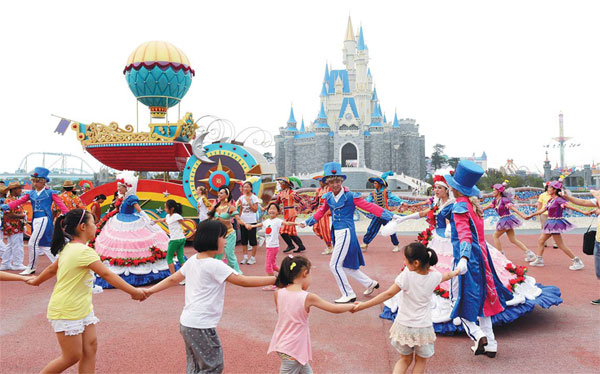Theme parks on the ride of their lives

Some had been reduced to virtual sideshows, but the industry has rediscovered its vigor
It was all supposed to be so much fun for investors, but for many the financial swings and roundabouts of the Chinese entertainment, leisure and tourism industry were as amusing as a stomach-churning ride on a roller coaster.
But that is changing as the industry begins to turn into the moneymaker it had always promised to be.
| Top, below: A European-style theme park in Shandong province attracts many visitors. Photos provided to China Daily |

Riding this wave, theme parks that had been losing money are now brimming with confidence as the country's swelling middle class realize that when they want to escape the humdrum of life, a visit to a theme park is not a bad option, and is relatively cheap as well.
Industry experts say that in recent years, China's theme park business has grown much more quickly than that of most countries, which may partly reflect the world's economic woes forcing consumers to crimp on their discretionary spending. Given the country's size and population, the themed entertainment industry has huge potential for growth, experts say.
The International Association of Amusement Parks and Attractions says that 180 million people went through the turnstiles of theme parks in China in 2013, 6 percent more than in the previous year. It predicts that the number of visits will surpass 320 million a year by 2020, overtaking the figure in the United States.
"About 700 million Chinese can now afford to visit theme parks," says Chris Yoshii, vice-president of AECOM, a Hong Kong consulting firm. As incomes continue to grow, that figure is forecast to shoot up to 1 billion in the next five years, he says.
Not only is China's emerging middle class increasingly attracted to theme parks, but it has nothing against spending as much as $31 (27 euros) on an entrance ticket, he says.
"Based on increasing population in the middle and upper income groups, and booming tourism, we expect the theme park market to have doubled from 2010 to 2015, and nearly double again from 2015 to 2020," Yoshii says.
The resurgence in the industry is thanks in part to a change of heart by the central government in 2013 when it lifted a ban on approvals for new theme park projects that had been imposed in 2011.
As developers and local governments sought to add entertainment facilities to commercial centers, resorts and residential communities, the number of theme park and water park projects began to surge.
The Chinese Culture and Media Industry Investment Report says China had more than 3,000 theme parks last year, almost one third of them less than two years old.
Among those looking for a piece of the action in China's amusement industry are international theme park companies.
The $5 billion Shanghai Disney Resort is due to open next year, followed by the $2.4 billion DreamWorks Dream Center in Shanghai in 2017 and the $3.3 billion Universal Studios Beijing about 2019.
Owners of popular foreign cartoon characters such as the Smurfs, Hello Kitty and Angry Birds have also opened theme parks in China.
"Culture from abroad is attractive to Chinese theme park visitors," says Chen Shaohui, managing director of Ipsos in China, the US-based global market research company. China is the undisputed star of the world theme park industry, he says.
"The market here is far from saturated, and for newcomers, whether they are local or from overseas, their investments put them in the box seat to gain a strong foothold as things become more competitive," Chen says.
The newly opened theme parks are concentrated in two clusters, he says, in the northeast and in the southeast. Beijing and Tianjin are at the heart of developments in the northeast, while the Pearl River Delta region and Hainan province are the gravitational points in the southeast.
Last year the central government gave the green light to the Universal Studios movie theme park in Beijing, the first of its kind in China. It will initially be built on 120 hectares and may eventually expand to 400 hectares.
"China's fast-growing economy, as well as Beijing's huge population and its attraction for thousands of visitors is the major reason why we are building the park here," says Tom Williams, chairman and CEO of Universal Parks and Resorts.
The complex will be in Tongzhou, a suburb in eastern Beijing. It will blend China's rich cultural heritage with Universal Parks and Resorts' brand of family entertainment, Williams says.
"Universal Beijing will create a higher level of economic growth, understanding and cultural exchange between our two countries. Together, we will create a unique experience that spotlights hugely popular Western entertainment concepts as well as China's rich cultural legacy. This will be an opportunity to build relationships with the Chinese people on a direct and personal level."
Duan Qiang, chairman of Beijing Tourism Group and BSH Investment, says Universal Beijing will showcase blockbuster movie themes and present entertaining family shows.
"After 13 years of preparation we are excited that we finally reached a deal. In that time people's lives have improved greatly. More than 250 million people travel to Beijing each year, and it is that huge market that makes us so confident about the project."
In March last year, DreamWorks Animation and its Chinese partners unveiled designs for a $2.4 billion entertainment complex in Shanghai.
Shanghai Disneyland Resort, the first Disney park on the Chinese mainland, is due to open in the Pudong New Area in the city. Some time over the next 10 years, the two will have competition from another US company, Six Flags theme parks, which says it plans to bring six parks to China in that time.
"For them, the challenge is how to blend in enough local elements to appeal to the broad Chinese public," Chen of Ipsos says.
As those foreign investors prepare for their China debut, Chinese theme park operators have been building or elaborating plans for China-centric theme parks amid fears that local parks will be forced to play second fiddle to the competition.
Wanda Group, China's biggest real estate company and owner of the world's largest cinema chain, says it plans to build 200 children's theme parks by 2020.
"When we compete with foreign amusement parks, we need to create a distinctive local culture brand," says Sheng Wubing, CEO of Romon World Amusement Park, covering 200,000 square meters in Ningbo, Zhejiang province, which opened last year.
"You can bring in the very best equipment from overseas and give the public a thrilling experience, but the important thing is what cultural experience you give them."
Many Chinese theme park operators have spent a lot on equipment from abroad, but most parks lack a coherent theme, he says.
Romon World is part of the Romon Hopsca project sponsored by Romon Group Co, a Ningbo garment company. The 5-billion-yuan ($800 million; 707 million euros) project includes the construction of a five-star hotel, an office building, a shopping mall, a convention center, and apartment units. The theme park combines indoor and outdoor areas to allow for year-round operation.
Wu says the complex is not only a place for entertainment but also for other activities such as shopping and dining, providing one-stop service.
"This is the way theme parks in China are beginning to develop, and I think it will eventually become mainstream."
Ningbo is a 90-minute train ride from Shanghai, and Wu says that when Disneyland opens, its proximity may affect his business.
"Revenue from ticket sales is still the mainstay of Chinese theme parks, accounting for nearly 80 percent, but at international theme parks such as Disney, dining, shows and souvenirs account for half their revenue."
However, Wu says he does not fear having to compete with the likes of Mickey Mouse. "The two parks are quite different and have different target audiences. We have more fun rides for adults."
Theme parks are capital intensive and require significant reinvestment, he says, and new technologies are needed for cost effective and adaptable attractions.
But Chen of Ipsos says few theme parks can properly call themselves that.
"Because of the short history of the domestic amusement industry, most domestic amusement parks try to copy successful foreign models. They put a piece of this or that in one park, and you get something where nothing fits together."
Lin Feng, head of Beijing New Dimension Planning & Design Institute Ltd, says that compared with foreign giants, domestic parks lack brand appeal, so in addition to stronger brand-building efforts, they need to correctly position themselves in the market, reduce ticket prices and make good use of Chinese elements to be more attractive culturally.
"Only by continuing to tap into the cultural aspects of tourism products can you increase brand attraction and have more repeat customers."
Hu Yuanyuan contributed to this story.
liulu@chinadaily.com.cn
(China Daily Africa Weekly 02/06/2015 page14)
Today's Top News
- Unified national market a new growth launchpad
- US deal a structural challenge for Japan
- Industrial prowess of China a subject of serious study
- US new tariffs 'unfair': Experts
- NDRC recalibrating steps to drive growth, boost demand
- Wartime hero's legacy fortifies Sino-UK bond































